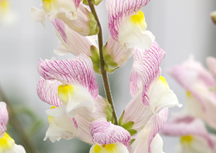Landing lights for bees - how Snapdragon flowers got their stripes

13 October 2010 Landing lights for bees, or nature’s way of inviting bees to sample the nectar and pollen in a flower gives us beautiful flowers often with intricate colour patterns.
Scientists at Plant & Food Research (New Zealand) and at John Innes Centre (UK) have been studying these patterns and found the importance of colour patterns to pollinators, how plants control where colour is formed and how evolution may generate the diversity of colours and forms in our garden and crop plants. The work was supported by the Marsden Fund from the Royal Society of New Zealand.
Dr Kathy Schwinn led the project at Plant & Food Research that explored how different colour patterns are formed in the petals of snapdragon (Antirrhinum majus) flowers.
She says her team found stripes in the petals of snapdragon result from the interaction of two signals; one from the veins of the petals and one from the epidermal layer (the skin of the petals).
The interaction of these two signals produces red anthocyanin pigments. Anthocyanins are responsible for red, blue and purple colour in plants.
Professor Cathie Martin from John Innes Centre in the UK led work on pollinators and says stripes following the veins of flowers are one of the most common floral pigmentation patterns so they wanted to explore what it meant for pollination.
Nuffield scholars observed foraging patterns of bumblebees on snapdragon plants on a plot near Norwich and found the bumblebees visited red flowers and those with venation patterning significantly more often than white or pink flowers.
“Stripes provide a visual guide for pollinators, directing them to the central landing platform and the entrance to the flower where the nectar and pollen can be found,” says Professor Martin.
“We examined the origin of this trait and found that it has been retained through snapdragon ancestry. The selection pressure for this trait is only relaxed when full red pigmentation evolves in a species.”
Bumblebees are the main pollinators for snapdragon because the weight of the bee is needed to open the closed flower.
Background
• Reference: The molecular basis for venation patterning of pigmentation
and its effect on pollinator attraction in flowers of Antirrhinum, New Phytologist, October 2010
• Plant & Food Research is a New Zealand based science company focused on generating knowledge that ensures sustainable growth in the plant and marine-based food industries. With over 900 staff based at sites across New Zealand and globally, Plant & Food Research provides research and development that adds value to fruit, vegetable, crop and food products. Our science in key areas – including elite cultivar development, sustainable production systems and bioprotection – supports the production of high quality produce that earns a premium in international markets. Our research in food science and the consumer drives the design and development of new and novel functional foods that offer benefits to human health and wellbeing.
• The John Innes Centre, http://www.jic.ac.uk is an independent, world-leading research centre in plant and microbial sciences with over 800 staff. JIC is based on Norwich Research Park and carries out high quality fundamental, strategic and applied research to understand how plants and microbes work at the molecular, cellular and genetic levels. The JIC also trains scientists and students, collaborates with many other research laboratories and communicates its science to end-users and the general public. The JIC is grant-aided by the Biotechnology and Biological Sciences Research Council, www.bbsrc.ac.uk.
Contact:
Iona Boase
Senior Communications Advisor, Marketing & Communications,
Plant & Food Research Palmerston North,
Food Industry Science Centre, Batchelar Rd
Palmerston North, 3374, New Zealand
EMail: media@plantandfood.co.nz
Telephone: +64-6-355 6136
Mobile: +64-27-4737 080
